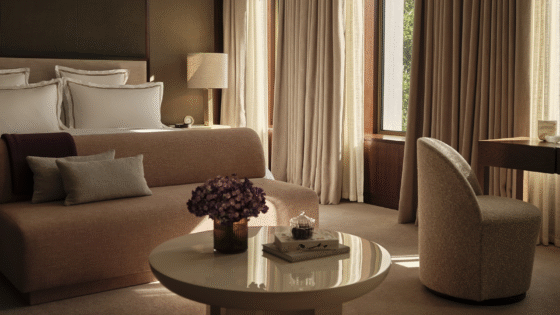Philip Jaffa who as Founder of Scape Design, is best known for experiential and environmentally sensitive landscape design in the international hospitality arena, has created an urban forest which is the centrepiece of the London Design Biennale at Somerset House this month…

Working in close collaboration with acclaimed artist, designer and Artistic Director of the Biennale, Es Devlin, who conceived the project, as well as with urban greening specialists, Scotscape, landscape designer Philip Jaffa has shaped an extraordinary journey of contemplation for visitors as they wander the pathways of Forest for Change leading to The Global Goals Pavilion where they will discover an interactive display of the 17 UN Global Goals for Sustainable Development.
The forest will comprise more than 400 juvenile trees, the majority sourced from one of the UK’s leading tree growers. They have been individually selected for their differing canopy shapes, heights and forms to achieve a layered aesthetic and to shroud the glade where the Development Goals lie at the heart of the experience. To highlight the plight of trees in urban environments due to climate change, the team chose a diverse range of 27 nursery grown species with the aim of ensuring resilience in the London environment. These include many favourite common species such as Scots Pine, Hazel and Silver Birch.
Endorsing this decision, Tony Kirkham, MBE VMH, Head of Arboretum, Gardens & Horticulture Services, Royal Botanic Gardens, Kew, says: “The only way to ensure future resilience of our new forest and tree plantings is to plant as much diversity of species as possible.”
Since the existing courtyard floor is an unmovable hardscape of cobbles, the trees will remain in their containers for the duration of the event and these will be covered in bark mulch mounds underplanted with forest floor species such as periwinkle, ivy and ferns. A sculptural array of logs and branches will also be spread across the ground to suggest the sights and smells of centuries-old woodlands and the stroll through the forest will be made to the accompaniment of birdsong in a soundtrack curated by pioneering musician Brian Eno.
“The invitation to wander through Forest for Change will be an opportunity for each visitor to find their way using intuition as their guide,” says Philip Jaffa. “Our disconnection from nature is at the heart of the global climate crisis, with such terrible effect on our planet, but forests have long been held as places of transformation and our hope is that the experience of our forest will contribute to inspiring change. The irony of constructing a forest in a courtyard where Enlightenment principles meant trees were forbidden when Somerset House was built has not been lost on us. The forest represents a challenge to the presumption that we are here to dominate nature, rather than as an integral part of it.”
The environmental impact of Forest for Change has been an important consideration throughout. All the trees will be donated to and replanted in London boroughs as part of The Queen’s Green Canopy initiative, creating a durable legacy for the forest after the Biennale and the cork and bark pathways will be re-used or recycled. The project will be carbon positive, planting sufficient trees after the Biennale to offset its carbon footprint three times over.
Forest for Change – The Global Goals Pavilion is being presented in partnership with Project Everyone, a not-for-profit agency dedicated to furthering awareness and engagement with the Global Goals. Lighting design is by John Cullen Lighting.
Main image credit: Somerset House/Kevin Meredith




